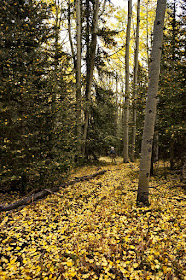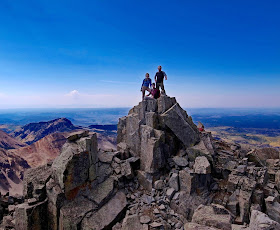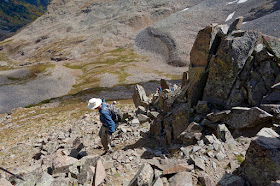Travel: From the Mercantile in Sawpit, CO, drive 1.1 miles west on CO 145 to mile marker 81.2. This is three miles east of the intersection of CO 145 and CO 62 coming from Ridgway. Turn left/south on Fall Creek Road, 57P. Zero-out your trip meter. Cross the San Miguel River. Pavement ends at 2.4 miles. At 3.8 miles, bear right, staying on 57P, following the sign to Woods Lake. Enter the Uncompahgre National Forest at 5.2 miles. Cross Fall Creek on a narrow bridge at 6.6 miles. At 7.5 miles, turn right at the sign for Beaver Park. Cross the creek and hang a 180. The road gets a little slower and rougher as it climbs through an aspen forest. Park at 9.4 miles where the road crosses the Hughes Ditch. The trailhead is marked with a symbol of a hiker. 2WD vehicles with decent clearance and tires should be able to make the trailhead.
Distance and Elevation Gain: 9.2 miles; 2,700 feet of climbing
Time: 5:00 to 6:00
Difficulty: Trail, off-trail; navigation moderate; mild exposure on summit ridge
Map: Little Cone, Colorado 7.5 Quad
Date Hiked: September 30, 2015
Quote: What happens when the leaves are falling,
and the trees are bare?
The golden wind revealed! Hekigan-roku
Little Cone may be glimpsed only once on the pleasant approach to the summit ridge.
Route: The first time we attempted Little Cone, we drove all over the region looking for a place to begin hiking that did not cross private land. Once we settled that (see the driving instructions above), we launched out. Having no route information, we spent another couple of hours working around fences, determined to stay on public land. We turned around 500 feet from the summit as night loomed. This charming peak lies in utter solitude because people do not know how to access it legally. Following, is all the information you need to do it right.
From Trailhead 9,500', go around the gate and walk northwesterly on the east side of Hughes Ditch. The service road is used by backhoes to keep the ditch flowing.
Follow the track through a thick conifer forest with generous interludes of aspen. Keep your eye out for the tiny opening through which you can see our south ridge route to Little Cone, pictured above.
Cross the second side drainage at 1.4 miles. An unobstructed view of the San Miguel Mountains opens. The 14'ers, El Diente Peak, Mount Wilson, and Wilson Peak will be visible for most of the hike. (THW, photo)
Follow the 9,500 foot contour alongside the ditch. At 1.8 miles, the road is blocked by a gate posted private property, no trespassing.
Retreat about 75 feet and cross the ditch on stones. Go up the embankment and onto a trail, shown. In August this was a wet crossing but in September the water was barely flowing. Equestrian travel keeps this path viable. While the trail is not indicated on maps (we stumbled on it during our first peak attempt), it appears to be maintained. Deadfall was freshly cut and cleared from the path.
Climb through a spruce and aspen mix. In 2.2 miles at 9,760 feet, the trail encounters a grassy slope and disappears. We got good and lost here the first time so we named this Maze Meadow. You need to locate the trail as it reappears on the other side of the clearing, kitty-corner. Walk north-northwest in a diagonally rising traverse. Looking at the image below, aim for the place where the tree crowns take a dip. Rejoin the trail in just a tenth of a mile.
The path continues northwest before turning briefly southwest. It comes close to a fence line at 2.6 miles, 10,060 feet. The track turns west to skirt the fence. The grade steepens as the treadway dodges massive aspen. Snowberry and low forest plants echo the crowns of the trees and everything simply glows. This is grouse territory. They seem to favor the thin band of fir trees at 10,600 feet.
[Please see Randy's comment below concerning new problems with private property incursion. The ascent is still possible. September, 2020]
The footpath crosses several small clearings before emerging onto a large grassy slope. At 3.8 miles, 11,040 feet, spruce separate to create a spacious opening with a clear view of Dolores Peak and Middle Peak, shown. We have reached the broad south ridge of Little Cone, our climbing route. Leave the trail and turn right/north into the woods.
Plow through trees and forest clutter. Reach a small talus field at 4.1 miles, 11,400 feet. Scamper up the short span of rock. Then enter a grove of scattered trees just west of the ridgecrest, shown. Climbing is fast and easy.
At 11,600 feet, 4.2 miles, the ridge thins and the land constricts at an obvious lookout. The shy mountain finally shows itself. Superb views only get better.
The approach is over. The summit ridge is strikingly beautiful. Ascend on large, stable Class 2 climbing talus. Mount the stone stairsteps that hover atop the curvilinear ridge. Stay near the mildly exposed edge for the greatest pleasure. (THW, photo)
Little Cone lives quietly in the shadow of dramatic Lone Cone, just ten miles west. I like to think that Lone Cone and Little Cone have a mutual understanding. They share a unique western location in the San Juan Mountains and are of similar geological composition, extrusive igneous volcanics. Despite its conical appearance, Lone Cone is not a volcano, and neither is Little Cone.
Crest the summit at 4.5 miles. It is long and flat. Walk 0.1 mile past multiple cairn edifices to the abrupt north edge. Bring gear and spend the night under the shelter of krumholtz. Lift your eyes above the mesmerizing variegated yellow sea, for this humble peak is graced with an astonishing vista. Sweeping around you will see the Abajo Mountains, Lone Cone, La Sal Mountains, Grand Mesa, West Elks, Mount Sneffels Wilderness, Sunshine Mountain, the Wilson clan, and Dolores-Middle-Dunn Ridge. In the image below, Telluride is tucked into the crevice image-center. Only in Colorado is there a horizon of infinite protrusions. (THW, photo)
Descend the summit ridge as you came. Regain the incoming trail and turn left.
Savor your walk through the aspen and spruce forest. When aspen leaves cling to spruce branches, I think of them as ornaments. There is nothing more elegant than a tall and lean, white-trunk aspen. Lower branches shed to leave delicate leaves quaking in the slightest breeze at the tastefully decorated crown. The Old Ones are regal and dignified. (THW, photo)
When you arrive at Maze Meadow the trail will be impossible to track. Aim for the break in the aspen, image-right and there you will find the trail once again. (THW, photo)
Little Cone barely emerges from treeline. But it is mighty and beautiful just the same.
The footpath crosses several small clearings before emerging onto a large grassy slope. At 3.8 miles, 11,040 feet, spruce separate to create a spacious opening with a clear view of Dolores Peak and Middle Peak, shown. We have reached the broad south ridge of Little Cone, our climbing route. Leave the trail and turn right/north into the woods.
Plow through trees and forest clutter. Reach a small talus field at 4.1 miles, 11,400 feet. Scamper up the short span of rock. Then enter a grove of scattered trees just west of the ridgecrest, shown. Climbing is fast and easy.
At 11,600 feet, 4.2 miles, the ridge thins and the land constricts at an obvious lookout. The shy mountain finally shows itself. Superb views only get better.
The approach is over. The summit ridge is strikingly beautiful. Ascend on large, stable Class 2 climbing talus. Mount the stone stairsteps that hover atop the curvilinear ridge. Stay near the mildly exposed edge for the greatest pleasure. (THW, photo)
Little Cone lives quietly in the shadow of dramatic Lone Cone, just ten miles west. I like to think that Lone Cone and Little Cone have a mutual understanding. They share a unique western location in the San Juan Mountains and are of similar geological composition, extrusive igneous volcanics. Despite its conical appearance, Lone Cone is not a volcano, and neither is Little Cone.
Crest the summit at 4.5 miles. It is long and flat. Walk 0.1 mile past multiple cairn edifices to the abrupt north edge. Bring gear and spend the night under the shelter of krumholtz. Lift your eyes above the mesmerizing variegated yellow sea, for this humble peak is graced with an astonishing vista. Sweeping around you will see the Abajo Mountains, Lone Cone, La Sal Mountains, Grand Mesa, West Elks, Mount Sneffels Wilderness, Sunshine Mountain, the Wilson clan, and Dolores-Middle-Dunn Ridge. In the image below, Telluride is tucked into the crevice image-center. Only in Colorado is there a horizon of infinite protrusions. (THW, photo)
Descend the summit ridge as you came. Regain the incoming trail and turn left.
Savor your walk through the aspen and spruce forest. When aspen leaves cling to spruce branches, I think of them as ornaments. There is nothing more elegant than a tall and lean, white-trunk aspen. Lower branches shed to leave delicate leaves quaking in the slightest breeze at the tastefully decorated crown. The Old Ones are regal and dignified. (THW, photo)
When you arrive at Maze Meadow the trail will be impossible to track. Aim for the break in the aspen, image-right and there you will find the trail once again. (THW, photo)
Little Cone barely emerges from treeline. But it is mighty and beautiful just the same.
























































